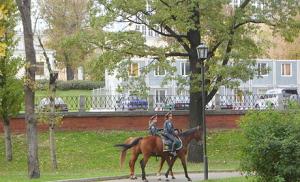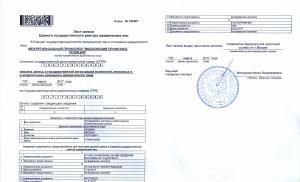How is soil different from parent rock? Soil solids
1. Soil science and its role in agriculture
soil science- this is the science of soils, their formation, structure, composition and properties; about the patterns of their geographical distribution; about the processes of interconnection with the external environment, which determine the formation and development of the most important property of soils - fertility; on the ways of rational use of soils in agriculture and forestry. This science is closely related to other disciplines studied by students of forest technical schools, such as forestry, forest crops, etc.
The most important of them were, firstly, a comparative assessment of the quality of land for various purposes, including the development of new lands for agriculture, and, secondly, an increase in soil productivity
2. 2. What is soil in the definition of the classics of soil science. How is it different from the breed?
The soil- this is a layer of matter lying on top of the rocks of the earth's crust, a special natural formation that plays a very important role in terrestrial ecosystems. The soil is a link between the biotic and abiotic factors of biogeocenosis. Soil science is the study of soils, the founder of which is Vasily Dokuchaev.
3. Soil as a four-phase system. Brief description of soil phases
solid phasesoil is a polydisperse organomineral system consisting of primary, secondary minerals and organic substances of plant and animal origin, as well as products of their interaction. It is the least dynamic and forms a framework for other phases, is characterized by certain morphological features, granulometric, mineralogical and chemical composition. Liquid phasesoil- this is water that occupies part of the pore space, coming in the form of precipitation and from groundwater, containing dissolved organic and mineral substances and therefore called soil solution. The soil solution is characterized by a certain chemical composition, acid-base and redox parameters and other indicators. It plays a leading role in chemical, biological, biochemical and other processes occurring in soils in the vertical and lateral (lateral) transfer of substances. It is a direct source of plant nutrition. The liquid environment is dynamic, the products of its functioning are updated during the day. gas phasesoil- this is soil air that fills the pore space free from water. Just like atmospheric air, soil air mainly consists of nitrogen, oxygen and carbon dioxide, but unlike atmospheric air, the content of oxygen and carbon dioxide in it varies greatly in time and space. The rate of renewal of the products of the functioning of the gas phase is generally comparable to the rate of renewal of the liquid phase. Live phasesoil(soil biota) are the organisms that inhabit the soil. These include microorganisms, bacteria, fungi, algae, representatives of soil microfauna; protozoa, insects, earthworms, etc. The assignment of plant roots living in the soil to the living phase of soils, as well as mammals, remains debatable, although their contribution to soil formation is very significant.
4. What is soil fertility. types of fertility.
Fertility is understood as the ability of the soil to satisfy the need of plants for nutrients, water, air and heat for normal growth and development.
For the gardener and gardener the most important factor is the quality of the land on his plot.
The different types have the following characteristics:
- structure;
- ability to pass air;
- hygroscopicity;
- heat capacity;
- density;
- acidity;
- saturation with micro and macro elements, organic matter.
clayey


This is a land with a high density, a weakly expressed structure, contains up to 80% clay, slightly warms up and releases water. Poorly passes air, which slows down decomposition in it. When wet, it is slippery, sticky, plastic. From it you can roll a bar 15-18 cm long, which is then easily rolled into a ring without cracks. Clay soils are usually acidic. It is possible to improve the agrotechnical indicators of clay soil in stages, over several seasons.
Important! For better heating of the beds in clay areas, they are formed high enough, the seeds are buried less into the ground. In autumn, before the onset of frost, they dig up the earth, do not break the lumps.
Optimize such soils by introducing:- lime to reduce acidity and improve aeration - 0.3-0.4 kg per sq. m, is brought in the autumn period;
- sand for better moisture exchange, no more than 40 kg / square meter;
- to reduce density, increase friability;
- to saturate with minerals;
- for replenishing organic matter, 1.5-2 buckets per sq. m per year.
This type of soil must be carefully loosened and mulched. and with a developed root system grow quite well on clay soils.
Did you know? Red grapes of technical grade« Merlot» grows well on clay-pebble soils of Pomerol, the smallest wine region in France, province of Bordeaux.
loamy


Outwardly similar to clay, but with the best for Agriculture characteristics. Loam, if you want to visualize what it is, is soil, which can also be rolled up into a sausage when wet and bent into a ring. A sample of loamy soil holds its shape, but will crack. The color of loam depends on impurities and can be black, gray, brown, red and yellow.
Due to neutral acidity, balanced composition (clay - 10-30%, sand and other impurities - 60-90%), loam is quite fertile and versatile, suitable for growing almost all crops. The structure of the soil is distinguished by a fine-grained structure, which allows it to remain loose and pass air well. Thanks to clay impurities, loam retains water for a long time.
To maintain the fertility of loams, perform:
- fertilizing crops with fertilizers;
- manure application for autumn digging.
Sandy


Light, loose, free-flowing sandy soil contains high percent sand, does not retain moisture and nutrients.
TO positive properties sandstones can be attributed to high air permeability and rapid heating. Grows well on this kind of soil.
- and berry trees;
- plants of the gourd family.
Sandstone can be cultivated by adding additives that increase viscosity:
 Sideration improves the mechanical structure and saturates it with organic and mineral substances.
Sideration improves the mechanical structure and saturates it with organic and mineral substances. To save resources, there is another method of organizing beds - a clay castle.
In place of the beds, a layer of clay 5-6 cm is poured, on top of which a layer of fertile soil is applied - loam, black soil, sandy loam soil, into which plants are sown. The clay layer will retain moisture and nutrients. If fertile soil is not available for planting beds, it can be replaced with improved sandstone mixed with additives for viscosity and fertility.
sandy loam


To determine this type of soil, we also try to mold a bagel from wet earth. Sandy loamy soil will roll into a ball, but it will not be possible to roll it into a bar. The content of sand in it is up to 90%, clay up to 20%. Another example of what kind of soils are that do not require costly and long cultivation. The substrate is light, warms up quickly, retains heat, moisture and organic matter well, and is quite easily processed.
It is necessary to choose zoned plant varieties for planting and maintain fertility:
- dosed application of mineral and organic fertilizers;
- mulching and sideration.
Lime


Soils of this type can be light and heavy, their disadvantages are:
Improve the following soil:- making
- enrichment with ammonium sulfate and to increase acidity;
- mulching;
- sideration;
- application of organic fertilizers.
Peat


These soils are highly acidic, warm slightly, and may become waterlogged.
However, they are quite easy to cultivate.
lover humid air and one of the most compact and rare pafinia orchids for most orchid growers is real star. Its flowering rarely lasts longer than a week, but it is an unforgettable sight. Unusual striped patterns on the huge flowers of a modest orchid want to be considered endlessly. In room culture, pafinia is rightly credited to the ranks of species that are difficult to grow. It became fashionable only with the spread of interior terrariums.
In 2014, the Japanese company Takii seed introduced a petunia with a striking salmon-orange petal color. By association with the bright colors of the southern sunset sky, the unique hybrid was named African Sunset (“African Sunset”). Needless to say, this petunia instantly won the hearts of gardeners and was in great demand. But in the last two years, the curiosity has suddenly disappeared from shop windows. Where did the orange petunia go?
In our family Bell pepper love, so we plant it every year. Most of the varieties that I grow have been tested by me for more than one season, I cultivate them all the time. And every year I try to try something new. Pepper is a heat-loving and rather whimsical plant. About varietal and hybrid varieties of tasty and productive sweet pepper, which grows well with me, and will be discussed further. I live in middle lane Russia.
Meatballs with broccoli in bechamel sauce are a great idea for a quick lunch or dinner. Start by cooking the minced meat, while bringing 2 liters of water to a boil to blanch the broccoli. By the time the cutlets are fried, the cabbage will be ready. It remains to collect the products in the pan, season with sauce and bring to readiness. Broccoli needs to be cooked quickly to keep it bright. green color, which, when cooked for a long time, either fades, or the cabbage becomes brown.
home floriculture- not only a fascinating process, but also a very troublesome hobby. And, as a rule, the more experience a grower has, the healthier his plants look. And what about those who do not have experience, but want to have a home houseplants- not stretched stunted specimens, but beautiful and healthy, not causing a feeling of guilt by their extinction? For beginners and flower growers who are not burdened with a long experience, I will tell you about the main mistakes that are easy to avoid.
Lush cheesecakes in a pan with banana-apple confiture is another recipe for everyone's favorite dish. So that cheesecakes do not fall off after cooking, remember a few simple rules. Firstly, only fresh and dry cottage cheese, secondly, no baking powder and soda, and thirdly, the density of the dough - you can sculpt from it, it is not tight, but pliable. A good dough with a small amount of flour will come out only from good cottage cheese, and here again, see the “firstly” paragraph.
It is no secret that many drugs from pharmacies migrated to summer cottages. Their use, at first glance, seems so exotic that some summer residents are perceived almost with hostility. At the same time, potassium permanganate is a long-known antiseptic, which is used both in medicine and in veterinary medicine. In crop production, a solution of potassium permanganate is used both as an antiseptic and as a fertilizer. In this article we will tell you how to properly use potassium permanganate in the garden and vegetable garden.
Pork meat salad with mushrooms is a rural dish that can often be found on holiday table in the village. This recipe is with champignons, but if possible, use Forest mushrooms, then be sure to cook it like this, it will be even tastier. You don’t need to spend a lot of time preparing this salad - put the meat in a saucepan for 5 minutes and another 5 minutes for slicing. Everything else happens almost without the participation of the cook - meat and mushrooms are boiled, cooled, marinated.
Cucumbers grow well not only in a greenhouse or conservatory, but also in open field. Cucumbers are usually sown from mid-April to mid-May. Harvesting in this case is possible from mid-July to the end of summer. Cucumbers do not tolerate frost. That's why we don't sow them too early. However, there is a way to bring their harvest closer and taste juicy handsome men from your garden at the beginning of summer or even in May. It is only necessary to take into account some features of this plant.
Polissias is a great alternative to classic variegated shrubs and woody ones. This plant's ornate round or feathery leaves create a strikingly festive curly crown, while its elegant silhouettes and modest personality make it a great candidate for being the largest plant in the house. Larger leaves do not prevent him from successfully replacing Benjamin and Co. ficuses. Moreover, poliscias offers much more variety.
Pumpkin cinnamon casserole is juicy and incredibly tasty, a bit like pumpkin pie, but, unlike pie, it is more tender and just melts in your mouth! This perfect recipe sweet pastries for families with children. As a rule, kids do not like pumpkin very much, but they never mind eating sweets. Sweet pumpkin casserole - delicious and healthy dessert, which, moreover, is prepared very simply and quickly. Try it! You'll like it!
The hedgerow is not only one of essential elements landscape design. She also performs various protective functions. If, for example, the garden borders on a road, or a highway passes nearby, then a hedge is a must. "Green walls" will protect the garden from dust, noise, wind and create a special comfort and microclimate. In this article, we will consider the optimal plants for creating a hedge that can reliably protect the site from dust.
In the first weeks of development, many cultures need a pick (and not even one), while others need a transplant "contraindicated". To "please" both of them, you can use not quite standard containers for seedlings. Another good reason to try them is to save money. In this article we will tell you how to do without the usual boxes, pots, cassettes and tablets. And let's pay attention to non-traditional, but very effective and interesting containers for seedlings.
Useful vegetable soup from red cabbage with celery, red onion and beets - a vegetarian soup recipe that can also be cooked in fast days. For those who decide to drop a few extra pounds, I will advise not to add potatoes, and reduce the amount a little olive oil(1 tablespoon is enough). The soup turns out to be very fragrant and thick, and in fasting you can serve a portion of soup with lean bread - then it will turn out satisfying and healthy.
The question of soil types for many summer residents, especially beginners, seems to be a “Chinese letter”: it is not clear how to determine this type, and in general, why such difficulties are needed. Meanwhile, it is here that the answers to many questions that concern us can be hidden.
Many years ago, my first garden was located on a plot near peat bogs. And I just could not understand why my beets do not grow. The potatoes come out excellent, strawberries, raspberries feel great, greenery pleases, but beets fail, even cry: miserable, stunted "tails", no matter how you look after them. And I was unaware that this vegetable does not like acidic soils (and I had just such a one). I decided then - "not my" plant. And then, already at another dacha, I grew beets without any hassle and worries - just sow and thin out on time, and harvest in the fall.
In general, in short, knowledge about the characteristics of different soils will help us decide on the choice of plants for the garden, and choose the right methods and techniques for cultivating our site. Moreover, to go into some purely scientific details in this case there is no need - for a start, the most general information.
The mechanical composition of the soil
This is one of key indicators, and at the same time - one of the easiest to understand and to define.Soils according to their mechanical composition are divided into:
- light (sandy and sandy)
- medium-heavy (loamy)
- heavy (clay).

The mechanical composition of the soil is easy to determine
To find out what kind of soil is on the site, we take a handful of earth, evenly moisten it so that it resembles a thick paste in consistency, and roll up a “sausage” about 3 mm thick. Then we try to roll it into a ring and evaluate what came of it:
- the soil rolls well, is plastic, the ring folds easily and keeps its shape - clay, heavy;
- the soil rolls into a "sausage", but cracks when you try to fold it into a ring - loamy;
- the soil crumbles, it is not possible to roll something whole out of it, it is impossible to fold a ring - sandy or sandy, light.
Why is it important to understand this? The mechanical composition of the soil determines its density, water and air permeability, moisture capacity. different types Soils are differently provided with the nutrients necessary for plants and require a different approach.

So, heavy soils richer in nutrition than the lungs. But they quickly compacted, after rain, their surface seizes with a crust. Water often stagnates on them, and plant roots suffer due to waterlogging. Beneficial microorganisms do not work well in such soils, organic matter slowly decomposes, and therefore nutritional deficiencies may occur. In spring, areas with similar soil warm up longer, and melt water leaves them later, so planting has to be started with some delay.
How to fix the situation? The main method is the introduction of loosening materials (usually sawdust or sand). Sand can be applied both in spring and autumn, but sawdust is preferably in autumn, and it is useful to moisten them with a solution of nitrogen fertilizer before use. Volumes and proportions are selected in each case, depending on the requirements of the crops that are planned to be planted, and the characteristics of the soil.
Sowing green manure also has a good effect; for sowing on heavy soils, it is desirable to choose crops with a strong root system that penetrates deep into the ground (for example, cereals).
Light soils do not retain water well, and along with water, they lose nutrients. But they provide good air exchange and warm up quickly in the spring. "Weighten" the soil, increase its moisture capacity by adding clay or pond silt (sapropel). The latter, however, requires pre-treatment: after extraction, it must be aired and frozen in order to get rid of chemical compounds harmful to plants.
Useful on light soils is the introduction of large doses of organic matter (rotted manure or compost). But peat should be used with caution: it has good moisture capacity, but it can increase the acidity of the soil, and is not of particular value in terms of nutrient content.
Soil acidity: how to determine and what affects
Another important parameter for us is the reaction of the soil. Why is he important? At the very beginning, I already gave an example with beets, which will not grow in acidic soil. And there are many such plants. In general, there are 4 groups of cultures, depending on their relationship to this factor:- first group- plants that prefer neutral and slightly alkaline soils (pH 6.0 or more): beets, pumpkins, squash, White cabbage, onions and garlic, peas, beans, celery, cherries, plums and currants, daffodils, tulips, hyacinths, asters, cloves and others;
- second group- plants that require a neutral or slightly acidic soil reaction (pH 5.6-6.0): carrots, cucumbers, lettuce, cauliflower and kohlrabi, apple, pear, begonias, gladioli, roses and others;
- third group- plants for which a slightly acidic soil reaction (pH 5.1-5.5) will be favorable: potatoes, corn, tomatoes, radishes, raspberries and blackberries, gooseberries, hazel, western thuja, irises, primroses, lilies, pelargonium and others;
- fourth group- plants that prefer acidic soils (pH 4.0-4.5): sorrel, Scots pine, azaleas and rhododendrons, heathers, lily of the valley, lingonberries and cranberries, blueberries.

However, most crops adapt quite easily to fluctuating pH levels, and in the specialized literature you can find conflicting information about the preferences of one or another species. Typical calcephobes(lovers of acidic soils) and calciphils(those that prefer alkaline soils) are relatively few. And yet, if the requirements of the plant are not taken into account when planting, this will most likely lead to its diseases, starvation, underdevelopment or death.
In soils with increased level acidity, nitrogen nutrition is disturbed; plants also do not receive sufficient amounts of phosphorus, calcium and magnesium, since their content is low or these substances are in a form inaccessible to plants. But there are other compounds that are toxic to the root system. Acidity soil provokes diseases, because pathogenic microflora under such conditions develops faster.
However, the alkaline reaction is no better: here the plants are deficient in magnesium and iron, their leaves turn yellow and fall off. Cultures unadapted to such conditions get sick, form deformed fruits, and often die.
Read also:
How to determine the reaction of the soil
The most accurate and simple method is to take the sample for analysis to a specialized laboratory. But this is far from always possible, so we will manage with improvised means.A rough estimate can be given by the vegetation typical of the site. But keep in mind: this method is only suitable if you got virgin land. On soils that have already been cultivated, plants are not a reliable indicator. However:
- on the acidic soil indicate moss, sedge, horsetail, sorrel;
- sign neutral reaction soils serve as coltsfoot, clover, gout and nettle;
- on the slightly alkaline soils quinoa and field mustard grow

The soil is poured with water (10 g of soil per 25 g of water; you can double the amount if you prefer), shake or mix thoroughly and allow to settle. Then a strip of indicator paper is lowered into the resulting extract and they look at what color it turned into:
- red - high acidity
- orange - medium acid soil
- yellow-orange - weak acidity
- yellow-green - neutral reaction
- greenish-blue - alkaline soil.
For the horizons, a letter designation is adopted, which makes it possible to record the structure of the profile. For example, for sod-podzolic soil: A 0 -A 0 A 1 -A 1 -A 1 A 2 -A 2 -A 2 B-BC-C .
The following types of horizons are distinguished:
- Organogenic- (litter (A 0, O), peat horizon (T), humus horizon (A h, H), sod (A d), humus horizon (A), etc.) - characterized by biogenic accumulation of organic matter.
- Eluvial- (podzolic, glazed, solodized, segregated horizons; denoted by the letter E with indices, or A 2) - characterized by the removal of organic and / or mineral components.
- illuvial- (B with indices) - characterized by the accumulation of matter removed from the eluvial horizons.
- Metamorphic- (B m) - are formed during the transformation of the mineral part of the soil in place.
- Hydrogen storage- (S) - are formed in the zone of maximum accumulation of substances (highly soluble salts, gypsum, carbonates, iron oxides, etc.) brought by groundwater.
- Cow- (K) - horizons cemented by various substances (highly soluble salts, gypsum, carbonates, amorphous silica, iron oxides, etc.).
- gley- (G) - with prevailing reducing conditions.
- Subsoil- parent rock (C) from which the soil was formed, and underlying underlying rock (D) of a different composition.
Soil solids
The soil is highly dispersed and has a large total surface of solid particles: from 3-5 m² / g for sandy soils to 300-400 m² / g for clay soils. Due to the dispersity, the soil has significant porosity: the pore volume can reach from 30% of the total volume in waterlogged mineral soils to 90% in organogenic peat soils. On average, this figure is 40-60%.
The density of the solid phase (ρ s) of mineral soils ranges from 2.4 to 2.8 g / cm³, organogenic: 1.35-1.45 g / cm³. Soil density (ρ b) is lower: 0.8-1.8 g/cm³ and 0.1-0.3 g/cm³, respectively. Porosity (porosity, ε) is related to densities by the formula:
ε = 1 - ρ b /ρ s
The mineral part of the soil
Mineral composition
About 50-60% of the volume and up to 90-97% of the mass of the soil are mineral components. The mineral composition of the soil differs from the composition of the rock on which it was formed: the older the soil, the stronger this difference.
Minerals that are residual material during weathering and soil formation are called primary. In the zone of hypergenesis, most of them are unstable and are destroyed at one rate or another. Olivine, amphiboles, pyroxenes, and nepheline are among the first to be destroyed. More stable are feldspars, which make up up to 10-15% of the mass of the solid phase of the soil. Most often they are represented by relatively large sand particles. Epidote, disthene, garnet, staurolite, zircon, tourmaline are distinguished by high resistance. Their content is usually insignificant, however, it makes it possible to judge the origin of the parent rock and the time of soil formation. The most stable is quartz, which weathers over several million years. Due to this, under conditions of prolonged and intense weathering, accompanied by the removal of mineral destruction products, its relative accumulation occurs.
The soil is characterized by a high content secondary minerals, formed as a result of deep chemical transformation of primary, or synthesized directly in the soil. Particularly important among them is the role of clay minerals - kaolinite, montmorillonite, halloysite, serpentine and a number of others. They have high sorption properties, a large capacity of cation and anion exchange, the ability to swell and retain water, stickiness, etc. These properties largely determine the absorption capacity of soils, its structure and, ultimately, fertility.
The content of minerals-oxides and hydroxides of iron (limonite, hematite), manganese (vernadite, pyrolusite, manganite), aluminum (gibbsite) and others is high, which also strongly affects the properties of the soil - they are involved in the formation of the structure, the soil absorbing complex (especially in heavily weathered tropical soils), take part in redox processes. Carbonates play an important role in soils (calcite, aragonite, see carbonate-calcium balance in soils). In arid regions, readily soluble salts (sodium chloride, sodium carbonate, etc.) often accumulate in the soil, affecting the entire course of the soil-forming process.
Grading

Ferret's triangle
Soils can contain particles with a diameter of less than 0.001 mm, and more than a few centimeters. A smaller particle diameter means a larger specific surface, and this, in turn, means larger values of cation exchange capacity, water-holding capacity, better aggregation, but less porosity. Heavy (clay) soils may have problems with air content, light (sandy) - with water regime.
For a detailed analysis, the entire possible range of sizes is divided into sections called factions. There is no single classification of particles. In Russian soil science, the scale of N. A. Kachinsky is adopted. The characteristic of the granulometric (mechanical) composition of the soil is given on the basis of the content of the fraction of physical clay (particles less than 0.01 mm) and physical sand (more than 0.01 mm), taking into account the type of soil formation.
The determination of the mechanical composition of the soil according to the Ferre triangle is also widely used in the world: on one side, the proportion of silt is deposited ( silt, 0.002-0.05 mm) particles, according to the second - clay ( clay, <0,002 мм), по третьей - песчаных (sand, 0.05-2 mm) and the intersection of the segments is located. Inside the triangle is divided into sections, each of which corresponds to one or another granulometric composition of the soil. The type of soil formation is not taken into account.
Organic part of the soil
The soil contains some organic matter. In organogenic (peat) soils, it can predominate, but in most mineral soils, its amount does not exceed a few percent in the upper horizons.
The composition of the organic matter of the soil includes both plant and animal remains that have not lost the features of the anatomical structure, as well as individual chemical compounds called humus. The latter contains both non-specific substances of a known structure (lipids, carbohydrates, lignin, flavonoids, pigments, wax, resins, etc.), which make up up to 10-15% of the total humus, and specific humic acids formed from them in the soil.
Humic acids do not have a specific formula and represent a whole class of macromolecular compounds. In Soviet and Russian soil science, they are traditionally divided into humic and fulvic acids.
Elemental composition of humic acids (by mass): 46-62% C, 3-6% N, 3-5% H, 32-38% O. Composition of fulvic acids: 36-44% C, 3-4.5% N, 3-5% H, 45-50% O. Both compounds also contain sulfur (from 0.1 to 1.2%), phosphorus (hundredths and tenths of a%). Molecular weights for humic acids are 20-80 kDa (minimum 5 kDa, maximum 650 kDa), for fulvic acids 4-15 kDa. Fulvic acids are more mobile, soluble throughout the entire range (humic acids precipitate in an acidic environment). The carbon ratio of humic and fulvic acids (C HA /C FA) is an important indicator of the humus status of soils.
In the molecule of humic acids, a core is isolated, consisting of aromatic rings, including nitrogen-containing heterocycles. The rings are connected by "bridges" with double bonds, creating extended conjugation chains, causing the dark color of the substance. The core is surrounded by peripheral aliphatic chains, including hydrocarbon and polypeptide types. The chains carry various functional groups (hydroxyl, carbonyl, carboxyl, amino groups, etc.), which is the reason for the high absorption capacity - 180-500 meq / 100 g.
Much less is known about the structure of fulvic acids. They have the same composition of functional groups, but a higher absorption capacity - up to 670 meq/100 g.
The mechanism of formation of humic acids (humification) is not fully understood. According to the condensation hypothesis (M. M. Kononova, A. G. Trusov), these substances are synthesized from low molecular weight organic compounds. According to the hypothesis of L. N. Alexandrova, humic acids are formed by the interaction of high-molecular compounds (proteins, biopolymers), then gradually oxidized and split. According to both hypotheses, enzymes, formed mainly by microorganisms, take part in these processes. There is an assumption about a purely biogenic origin of humic acids. In many properties, they resemble the dark-colored pigments of mushrooms.
soil structure
The structure of the soil affects the penetration of air to the roots of plants, the retention of moisture, and the development of the microbial community. Depending only on the size of the aggregates, the yield can vary by an order of magnitude. The optimal structure for plant development is dominated by aggregates ranging in size from 0.25 to 7-10 mm (agronomically valuable structure). An important property of the structure is its strength, especially water resistance.
The predominant form of aggregates is an important diagnostic feature of the soil. There are round-cubic (granular, lumpy, lumpy, dusty), prism-shaped (columnar, prismatic, prismatic) and slab-like (platy, scaly) structure, as well as a number of transitional forms and gradations in size. The first type is characteristic of the upper humus horizons and causes a large porosity, the second - for illuvial, metamorphic horizons, the third - for eluvial ones.
Neoplasms and inclusions
Main article: Soil neoplasms
Neoplasms- accumulations of substances formed in the soil in the process of its formation.
Neoplasms of iron and manganese are widespread, whose migratory ability depends on the redox potential and is controlled by organisms, especially bacteria. They are represented by concretions, tubes along the root paths, crusts, etc. In some cases, the soil mass is cemented with ferruginous material. In soils, especially in arid and semi-arid regions, calcareous neoplasms are common: plaque, efflorescence, pseudomycelium, concretions, crust formations. Gypsum neoplasms, also characteristic of arid regions, are represented by plaques, druses, gypsum roses, and crusts. There are new formations of easily soluble salts, silica (powder in eluvial-illuvial differentiated soils, opal and chalcedony interlayers and crusts, tubes), clay minerals (cutans - incrustations and crusts formed during the illuvial process), often together with humus.
TO inclusions include any objects that are in the soil, but not associated with the processes of soil formation (archaeological finds, bones, shells of mollusks and protozoa, rock fragments, debris). The assignment of coprolites, wormholes, molehills and other biogenic formations to inclusions or neoplasms is ambiguous.
Soil liquid phase
Conditions of water in the soil
Soil is divided into bound and free water. The first soil particles are so firmly held that it cannot move under the influence of gravity, and free water is subject to the law of gravity. Bound water, in turn, is divided into chemically and physically bound.
Chemically bound water is part of some minerals. This water is constitutional, crystallization and hydrated. Chemically bound water can only be removed by heating, and some forms (constitutional water) by calcining minerals. As a result of the release of chemically bound water, the properties of the body change so much that one can speak of a transition into a new mineral.
Physically bound water is retained by the soil by the forces of surface energy. Since the magnitude of the surface energy increases with an increase in the total total surface of the particles, the content of physically bound water depends on the size of the particles that make up the soil. Particles larger than 2 mm in diameter do not contain physically bound water; this ability is possessed only by particles having a diameter less than the specified one. In particles with a diameter of 2 to 0.01 mm, the ability to retain physically bound water is weakly expressed. It increases with the transition to particles smaller than 0.01 mm and is most pronounced in red colloidal and especially colloidal particles. The ability to retain physically bound water depends on more than just particle size. A certain influence is exerted by the shape of the particles and their chemical and mineralogical composition. Humus and peat have an increased ability to retain physically bound water. The particle holds the subsequent layers of water molecules with less and less force. It is loosely bound water. As the particle moves away from the surface, the attraction of water molecules by it gradually weakens. The water goes into a free state.
The first layers of water molecules, i.e. hygroscopic water, soil particles attract with tremendous force, measured in thousands of atmospheres. Being under such a high pressure, the molecules of tightly bound water are very close together, which changes many of the properties of water. It acquires the qualities of a solid body, as it were. The soil retains loosely bound water with less force, its properties are not so sharply different from free water. Nevertheless, the force of attraction is still so great that this water is not subject to the force of gravity of the earth and differs from free water in a number of physical properties.
Capillary duty cycle determines the absorption and retention of moisture brought by atmospheric precipitation in a suspended state. The penetration of moisture through the capillary pores into the depth of the soil is extremely slow. Soil permeability is mainly due to non-capillary off-duty ratio. The diameter of these pores is so large that moisture cannot be held in them in a suspended state and seeps into the soil without hindrance.
When moisture enters the soil surface, the soil is first saturated with water to the state of field moisture capacity, and then filtration through non-capillary wells occurs through the water-saturated layers. Through cracks, shrew passages and other large wells, water can penetrate deep into the soil, ahead of water saturation up to the field capacity.
The higher the non-capillary duty cycle, the higher the water permeability of the soil.
In soils, in addition to vertical filtration, there is horizontal intrasoil movement of moisture. Moisture entering the soil, encountering a layer with reduced water permeability on its way, moves inside the soil above this layer in accordance with the direction of its slope.
Interaction with the solid phase
Main article: Soil absorption complex
The soil can retain substances that have entered it through various mechanisms (mechanical filtration, adsorption of small particles, formation of insoluble compounds, biological absorption), the most important of which is ion exchange between the soil solution and the surface of the soil solid phase. The solid phase is predominantly negatively charged due to the spalling of the crystal lattice of minerals, isomorphic substitutions, the presence of carboxyl and a number of other functional groups in the composition of organic matter, therefore the cation-exchange capacity of the soil is most pronounced. However, the positive charges responsible for the anion exchange are also present in the soil.
The totality of soil components with ion-exchange capacity is called the soil absorption complex (SAC). The ions that make up the PPC are called exchange or absorbed ions. A characteristic of the CEC is the cation exchange capacity (CEC) - the total number of exchangeable cations of the same kind held by the soil in a standard state - as well as the amount of exchangeable cations that characterizes the natural state of the soil and does not always coincide with the CEC.
The ratios between the exchangeable cations of PPC do not coincide with the ratios between the same cations in the soil solution, that is, the ion exchange proceeds selectively. Preferably, cations with a higher charge are absorbed, and if they are equal, with a higher atomic mass, although the properties of the PPC components may somewhat violate this pattern. For example, montmorillonite absorbs more potassium than hydrogen protons, while kaolinite does the opposite.
Exchangeable cations are one of the direct sources of mineral nutrition for plants, the composition of the NPC is reflected in the formation of organomineral compounds, soil structure and its acidity.
Soil acidity
soil air.
Soil air consists of a mixture of various gases:
- oxygen, which enters the soil from atmospheric air; its content may vary depending on the properties of the soil itself (its friability, for example), on the number of organisms that use oxygen for respiration and metabolic processes;
- carbon dioxide, which is formed as a result of the respiration of soil organisms, that is, as a result of the oxidation of organic substances;
- methane and its homologues (propane, butane), which are formed as a result of the decomposition of longer hydrocarbon chains;
- hydrogen;
- hydrogen sulfide;
- nitrogen; more likely to form nitrogen in the form of more complex compounds (for example, urea)
And this is not all the gaseous substances that make up the soil air. Its chemical and quantitative composition depends on the organisms contained in the soil, the content of nutrients in it, the weathering conditions of the soil, etc.
Living organisms in the soil
Soil is a habitat for many organisms. Creatures that live in the soil are called pedobionts. The smallest of these are bacteria, algae, fungi, and single-celled organisms that live in soil water. Up to 10¹⁴ organisms can live in one m³. The soil air is inhabited by invertebrates such as mites, spiders, beetles, springtails and earthworms. They feed on plant remains, mycelium, and other organisms. Vertebrates also live in the soil, one of them is the mole. He is very well adapted to living in completely dark soil, so he is deaf and almost blind.
The heterogeneity of the soil leads to the fact that for organisms of different sizes it acts as a different environment.
- For small soil animals, which are united under the name of nanofauna (protozoa, rotifers, tardigrades, nematodes, etc.), the soil is a system of micro-reservoirs.
- For air-breathers of slightly larger animals, the soil appears as a system of shallow caves. Such animals are united under the name microfauna. The sizes of representatives of soil microfauna range from tenths to 2-3 mm. This group mainly includes arthropods: numerous groups of ticks, primary wingless insects (springtails, protura, two-tailed insects), small species of winged insects, centipedes symphyla, etc. They do not have special adaptations for digging. They crawl along the walls of soil cavities with the help of limbs or wriggling like a worm. Soil air saturated with water vapor allows you to breathe through the covers. Many species do not have a tracheal system. Such animals are very sensitive to desiccation.
- Larger soil animals, with body sizes from 2 to 20 mm, are called representatives of the mesofauna. These are insect larvae, centipedes, enchytreids, earthworms, etc. For them, the soil is a dense medium that provides significant mechanical resistance when moving. These relatively large forms move in the soil either by expanding natural wells by pushing apart soil particles, or by digging new passages.
- Soil megafauna or soil macrofauna are large excavations, mostly mammals. A number of species spend their entire lives in the soil (mole rats, mole voles, zokors, Eurasian moles, African golden moles, Australian marsupial moles, etc.). They make whole systems of passages and holes in the soil. The appearance and anatomical features of these animals reflect their adaptability to a burrowing underground lifestyle.
- In addition to the permanent inhabitants of the soil, among large animals, a large ecological group of burrow dwellers can be distinguished (ground squirrels, marmots, jerboas, rabbits, badgers, etc.). They feed on the surface, but breed, hibernate, rest, and escape danger in the soil. A number of other animals use their burrows, finding in them a favorable microclimate and shelter from enemies. Norniks have structural features characteristic of terrestrial animals, but have a number of adaptations associated with a burrowing lifestyle.
Spatial organization
In nature, there are practically no situations where any single soil with properties that are unchanged in space extends for many kilometers. At the same time, differences in soils are due to differences in the factors of soil formation.
The regular spatial distribution of soils in small areas is called the soil cover structure (SCC). The initial unit of SPP is the elementary soil area (EPA) - a soil formation within which there are no soil-geographical boundaries. ESAs alternating in space and to some extent genetically related form soil combinations.
soil formation
Soil-forming factors :
- Elements of the natural environment: soil-forming rocks, climate, living and dead organisms, age and terrain,
- as well as anthropogenic activities that have a significant impact on soil formation.
Primary soil formation
In Russian soil science, the concept is given that any substrate system that ensures the growth and development of plants "from seed to seed" is soil. This idea is debatable, since it denies the Dokuchaev principle of historicity, which implies a certain maturity of soils and the division of the profile into genetic horizons, but is useful in understanding the general concept of soil development.
The rudimentary state of the soil profile before the appearance of the first signs of horizons can be defined by the term "initial soils". Accordingly, the “initial stage of soil formation” is distinguished - from the soil “according to Veski” until the time when a noticeable differentiation of the profile into horizons appears, and it will be possible to predict the classification status of the soil. The term "young soils" is proposed to assign the stage of "young soil formation" - from the appearance of the first signs of horizons to the time when the genetic (more precisely, morphological-analytical) appearance is sufficiently pronounced for diagnosis and classification from the general positions of soil science.
Genetic characteristics can be given even before the maturity of the profile, with an understandable share of prognostic risk, for example, “initial soddy soils”; "young propodzolic soils", "young carbonate soils". With this approach, nomenclature difficulties are resolved naturally, based on the general principles of soil-ecological forecasting in accordance with the Dokuchaev-Jenney formula (representation of soil as a function of soil formation factors: S = f(cl, o, r, p, t ...)).
Anthropogenic soil formation
In the scientific literature for lands after mining and other disturbances of the soil cover, the generalized name “technogenic landscapes” has been fixed, and the study of soil formation in these landscapes has taken shape in “reclamation soil science”. The term "technozems" was also proposed, essentially representing an attempt to combine the Dokuchaev tradition of "-zems" with man-made landscapes.
It is noted that it is more logical to apply the term "technozem" to those soils that are specially created in the process of mining technology by leveling the surface and pouring specially removed humus horizons or potentially fertile soils (loess). The use of this term for genetic soil science is hardly justified, since the final, climax product of soil formation will not be a new "-earth", but a zonal soil, for example, soddy-podzolic or soddy-gley.
For technogenically disturbed soils, it was proposed to use the terms "initial soils" (from the "zero moment" to the appearance of horizons) and "young soils" (from the appearance to the formation of diagnostic features of mature soils), indicating the main feature of such soil formations - the time stages of their development. evolution from undifferentiated rocks to zonal soils.
Soil classification
There is no single generally accepted classification of soils. Along with the international one (FAO Soil Classification and WRB, which replaced it in 1998), many countries around the world have national soil classification systems, often based on fundamentally different approaches.
In Russia, by 2004, a special commission of the Soil Institute. V. V. Dokuchaeva, led by L. L. Shishov, prepared a new classification of soils, which is a development of the 1997 classification. However, Russian soil scientists continue to actively use the USSR soil classification of 1977.
Among the distinguishing features of the new classification, we can mention the refusal to use factor-environmental and regime parameters for diagnosis, which are difficult to diagnose and often determined by the researcher purely subjectively, focusing attention on the soil profile and its morphological features. A number of researchers see this as a departure from genetic soil science, which focuses on the origin of soils and the processes of soil formation. The 2004 classification introduces formal criteria for assigning soil to a particular taxon, and uses the concept of a diagnostic horizon, which is accepted in the international and American classifications. Unlike the WRB and the American Soil Taxonomy, in the Russian classification, horizons and characters are not equivalent, but are strictly ranked according to their taxonomic significance. Undoubtedly, an important innovation of the 2004 classification was the inclusion of anthropogenically transformed soils in it.
The American school of soil scientists uses the Soil Taxonomy classification, which is also widespread in other countries. Its characteristic feature is the deep elaboration of formal criteria for assigning soils to a particular taxon. Soil names constructed from Latin and Greek roots are used. The classification scheme traditionally includes soil series - groups of soils that differ only in granulometric composition and have an individual name - the description of which began when the US Soil Bureau mapped the territory at the beginning of the 20th century.
Soil classification - a system for dividing soils by origin and (or) properties.
- Soil type is the main classification unit, characterized by the commonality of properties determined by the regimes and processes of soil formation, and by a single system of basic genetic horizons.
- A soil subtype is a classification unit within a type, characterized by qualitative differences in the system of genetic horizons and in the manifestation of overlapping processes that characterize the transition to another type.
- Soil genus - a classification unit within a subtype, determined by the characteristics of the composition of the soil-absorbing complex, the nature of the salt profile, and the main forms of neoplasms.
- Soil type - a classification unit within a genus, quantitatively differing in the degree of expression of soil-forming processes that determine the type, subtype and genus of soils.
- Soil variety is a classification unit that takes into account the division of soils according to the granulometric composition of the entire soil profile.
- Soil category - a classification unit that groups soils according to the nature of soil-forming and underlying rocks.
- Soil variety is a classification unit that takes into account the division of soils according to the granulometric composition of the entire soil profile.
- Soil type - a classification unit within a genus, quantitatively differing in the degree of expression of soil-forming processes that determine the type, subtype and genus of soils.
- Soil genus - a classification unit within a subtype, determined by the characteristics of the composition of the soil-absorbing complex, the nature of the salt profile, and the main forms of neoplasms.
- A soil subtype is a classification unit within a type, characterized by qualitative differences in the system of genetic horizons and in the manifestation of overlapping processes that characterize the transition to another type.
Distribution patterns
Climate as a factor in the geographical distribution of soils
Climate, one of the most important factors in soil formation and geographic distribution of soils, is largely determined by cosmic causes (the amount of energy received by the earth's surface from the sun). The manifestation of the most general laws of soil geography is associated with climate. It affects soil formation both directly, by determining the energy level and hydrothermal regime of soils, and indirectly, by influencing other factors of soil formation (vegetation, vital activity of organisms, soil-forming rocks, etc.).
The direct influence of climate on the geography of soils is manifested in different types of hydrothermal conditions of soil formation. The thermal and water regimes of soils affect the nature and intensity of all physical, chemical and biological processes occurring in the soil. They regulate the processes of physical weathering of rocks, the intensity of chemical reactions, the concentration of soil solution, the ratio of the solid and liquid phases, and the solubility of gases. Hydrothermal conditions affect the intensity of the biochemical activity of bacteria, the rate of decomposition of organic residues, the vital activity of organisms and other factors, therefore, in different regions of the country with unequal thermal conditions, the rate of weathering and soil formation, the thickness of the soil profile and weathering products are significantly different.
The climate determines the most general patterns of soil distribution - horizontal zonality and vertical zonality.
The climate is the result of the interaction of climate-forming processes occurring in the atmosphere and the active layer (oceans, cryosphere, land surface and biomass) - the so-called climate system, all components of which continuously interact with each other, exchanging matter and energy. Climate-forming processes can be divided into three complexes: processes of heat exchange, moisture exchange and atmospheric circulation.
The value of soils in nature
Soil as a habitat for living organisms
The soil has fertility - it is the most favorable substrate or habitat for the vast majority of living beings - microorganisms, animals and plants. It is also significant that in terms of their biomass, the soil (the land of the Earth) is almost 700 times greater than the ocean, although the share of land accounts for less than 1/3 of the earth's surface.
Geochemical features
The property of different soils to accumulate various chemical elements and compounds in different ways, some of which are necessary for living beings (biophilic elements and microelements, various physiologically active substances), while others are harmful or toxic (heavy metals, halogens, toxins, etc.) , manifests itself in all plants and animals living on them, including humans. In agronomy, veterinary science and medicine, such a relationship is known in the form of so-called endemic diseases, the causes of which were revealed only after the work of soil scientists.
The soil has a significant impact on the composition and properties of surface and groundwater and the entire hydrosphere of the Earth. Filtering through the soil layers, water extracts from them a special set of chemical elements, characteristic of the soils of the catchment areas. And since the main economic indicators of water (its technological and hygienic value) are determined by the content and ratio of these elements, the disturbance of the soil cover also manifests itself in a change in water quality.
Regulation of the composition of the atmosphere
Soil is the main regulator of the composition of the Earth's atmosphere. This is due to the activity of soil microorganisms, which produce a variety of gases on a huge scale -













